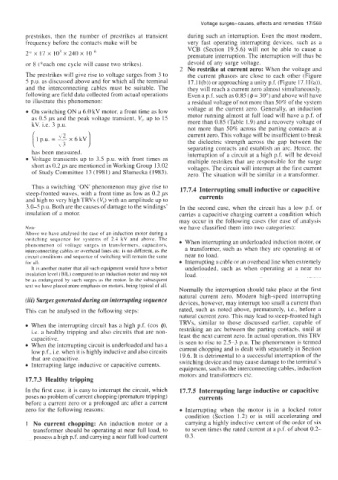Page 604 - Industrial Power Engineering and Applications Handbook
P. 604
Voltage surges-causes, effects and remedies 171569
prestrikes, then the number of prestrikes at transient during such an interruption. Even the most modern,
frequency before the contacts make will be very fast operating interrupting devices, such as a
2" x 17 x IO3 x 240 x 10 ' premature interruption. The interruption will thus be
VCB (Section 19.5.6) will not be able to cause a
or 8 ("each one cycle will cause two strikes). devoid of any surge voltage.
2 No restrike at current zero: When the voltage and
The prestrikes will give rise to voltage surges from 3 to the current phasors are close to each other (Figure
5 p.u. as discussed above and for which all the terminal 17.ll(b))orapproachingaunityp.f. (Figure l7.ll(a)),
and the interconnecting cables must be suitable. The they will reach a current zero almost simultaneously.
following are field data collected from actual operations Even ap.f. such as 0.85 (@= 30") and above will have
to illustrate this phenomenon: a residual voltage of not more than 50% of the system
voltage at the current zero. Generally, an induction
On switching ON a 6.0 kV motor, a front time as low
as 0.5 ps and the peak voltage transient, V,, up to IS motor running almost at full load will have a p.f. of
kV. i.e. 3 p.u. more than 0.85 (Table 1.9) and a recovery voltage of
not more than 50% across the parting contacts at a
(I p.u. = :t! 6 kV current zero. This voltage will be insufficient to break
x
2
1'
the dielectric strength across the gap between the
separating contacts and establish an arc. Hence, the
has been measured. interruption of a circuit at a high p.f. will be devoid
Voltage transients up to 3.5 p.u. with front times as multiple restrikes that are responsible for the surge
short as 0.2 ,us are mentioned in Working Group 13.02 voltages. The circuit will interrupt at the first current
of Study Committee 13 (1981) and Slamecka (1983). zero. The situation will be similar in a transformer.
Thus a switching 'ON' phenomenon may give rise to 17.7.4 Interrupting small inductive or capacitive
steep-fronted waves, with a front time as low as 0.2 ,us currents
and high to very high TRVs (V,) with an amplitude up to
3.0-5 p.u. Both are the causes of damage to the windings' in the second case, when the circuit has a low p.f. or
insulation of a motor. carries a capacitive charging current a condition which
may occur in the following cases (for ease of analysis
Note we have classified them into two categories):
Above we have analysed the case of an induction motor during a
switching sequence for systems of 2.4 kV and above. The When interrupting an underloaded induction motor, or
phenomenon of voltage surges in transformers, capacitors,
interconnecting cables or overhead lines etc. is no different, as the a transformer, such as when they are operating at or
circuit conditions and sequence of Fwitching will remain the same near no load.
for all. Interrupting a cable or an overhead line when extremely
It is another matter that all such equipment would have a better underloaded, such as when operating at a near no
insulation lcvel (BIL) compared to an induction motor and may not load.
he as endangered by such surges as the motor. In the subsequent
text we have placed more emphasis on motors. being typical of all.
Normally the interruption should take place at the first
natural current zero. Modern high-speed interrupting
(iii) Surges generated during an interrupting sequence devices, however, may interrupt too small a current than
This can be analysed in the following steps: rated, such as noted above, prematurely, i.e., before a
natural current zero. This may lead to steep-fronted high
TRVs, similar to those discussed earlier, capable of
When the interrupting circuit has a high p.f. (cos @), restriking an arc between the parting contacts, until at
i.e. a healthy tripping and also circuits that are non- least the next current zero. In actual operation, this TRV
capacitive.
When the interrupting circuit is underloaded and has a is seen to risc to 2.5-3 p.u. The phenomenon is termed
low p.f., i.e. when it is highly inductive and also circuits current chopping and is dealt with separately in Section
that are capacitive. 19.6. It is detrimental to a successful interruption of the
Interrupting large inductive or capacitive currents. switching device and may cause damage to the terminal's
equipmcnt, such as the interconnecting cables, induction
motors and transformers etc.
17.7.3 Healthy tripping
In the first case, it is easy to interrupt the circuit, which 17.7.5 Interrupting large inductive or capacitive
poses no problem of current chopping (premature tripping) currents
before a current zero or a prolonged arc after a current
zero for the following reasons: Interrupting when the motor is in a locked rotor
condition (Section 1.2) or is still accelerating and
1 No current chopping: An induction motor or a carrying a highly inductive curretit of the order of six
transformer should be operating at near full load, to to seven times the rated current at a p.f. of about 0.2-
possess a high p.f. and carrying a near full load current 0.3.

